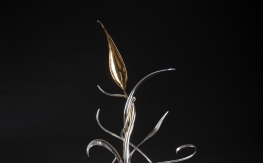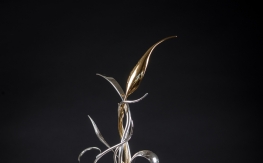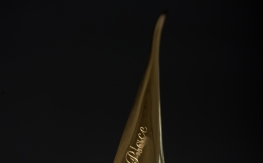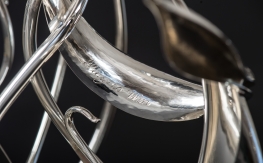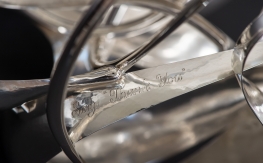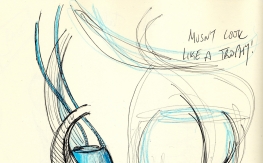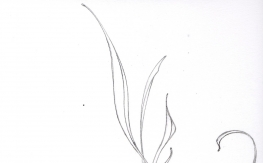Sarah Denny's portfolio
'That Infidel Piece'
Sterling silver hand raised and forged with gold plate detail, 2014
Description : A centrepiece privately commissioned for Girton College Hall, Girton College, Cambridge
'That Infidel Piece' was commissioned by Pamela Maryfield, a past student of Girton who wanted to gift the historical college with a unique piece of silver. Sarah Denny was chosen due to her Yorkshire residence where Maryfield was originally from herself. Having a female Yorkshire-woman was also very apt given the College’s history of being the first college for women. Muriel Bradbrooke’s ‘That Infidel Place’ explains the story of the origin of the famous quotation: ‘Ha! This is Hitchin, and that, I believe, is the house where the College for Women is: that infidel place!’ - hence where the piece’s title and engraving originates.
A few words about design : My commissioner, Pamela, and I decided we wanted to design a sculptural centrepiece as opposed to anything functional or domestic - something a little flamboyant in order to create an eye-catching piece. Pamela had ideas of using Girton’s architecture as a starting point, the college’s main Tower being one. She had thoughts of The Tower of Babel and its suggestive spiralling effect, and we thought a connection could be made. This instigated my visit to Girton last summer, which provided a copious supply of visual inspiration.
On inspection I found a strong blend of organic fluid designs alongside harsher geometric and more precise design. Symmetry of shape was everywhere, from the arches within the windows and corridors, to that of the shapes in the stained glass. But fluid flowing lines motivate me most and the beautiful symmetrical designs of the more fluid style windows are what caught me first, simple curvature and twisting stems, leading to plump flowers at the top of the window. It reflected well with the examples of the staircases - an old spiral one in particular excited me, where the thick concrete twists and curves grew alongside the more spindly wooden handrail and the strong metal frame in between to add to the mix. Simple elegant diverse components - working together well, and beautifully. From this I had thoughts of fine elements alongside chunky ones – weaving and contrasting, varying layers tightly and loosely woven, rolls of tubulars – wrapping and winding!
It was the reference to geometry in nature specifically which caught my attention. Again the flowing lines and snaking curves most notable in the examples of the woodcarvings, in particular those in the hall panels, as well as some in the chapel. Beautiful bold hand carved leaves, sweeping branches and vines, all layered and intertwining organically, and yet set out as a whole in symmetric format. Interesting too are the forms found in the chapel – stems of wheat in perfect symmetry, open flowers confined in square cells with circles encasing too.
Needless to say I could not believe what a visual feast of shapes, lines and fantastic detail could be found so readily. Girtonian imagery has undoubtedly played an important role in quite magically inspiring this smithing of silver, to hopefully have created a very fluid and dynamic feeling piece, one that is forged and raised to be as distinctive as was first hoped.
Some points of interest : The piece is made of 12 separate component sections, joined by 42 rivets, through 82 drill holes.
A few points of explanation from my Commissioner :
“The name: a typo, where Infidel Place became Piece and it stuck.
The script: an idea from the College, perhaps to encourage conversation.
Play to Win - has raised the odd eyebrow, is attributed to Lord Hawke, a great captain of Yorkshire County Cricket Club, 1893-1910 (and of Cambridge University).
Say ‘Thank You’ - the title of Jean Lindsay's book of etiquette and used here by way of a tribute to her.â€
Dimensions : H610 x W280 x D280mm

